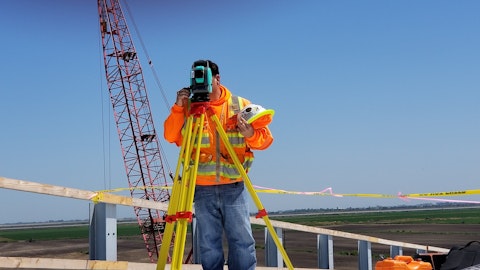Michael Sison: Got it. Thanks.
Operator: The next question is from Aleksey Yefremov with KeyBanc. Please go ahead.
Ryan Weis: Good morning. This is Ryan on for Aleksey. I kind of wanted to piggyback off of the last pricing question there. So, I was wondering if you could maybe talk about how pricing is trending on bids for new projects in both CPG and PCG.
Frank Sullivan: Well, in general, we have held price across most RPM businesses. Very few exceptions and the exceptions tend to be more commodity spaces around epoxy resins or silicones. We participate in line striping and in bridge and highway work and that tends to be a little more price-sensitive because they tend to have basic coatings that are more directly related to the underlying chemical raw materials.
Ryan Weis: Okay. That’s helpful. Thank you. And then, can you just maybe talk about what you guys are seeing in the repair and maintenance business? Obviously, it’s held up relatively well. Is this business still growing? Or any color here would be great. Thank you.
Frank Sullivan: Absolutely, it’s holding up really well. You can see that in our Construction Products Group. The vast majority of that is repair and maintenance. And then also industrial capital spending, which seems to be pretty solid. That also impacts our Performance Coatings Group. So, we’re pushing, as I mentioned earlier, other opportunities. I mentioned the Pure Air acquisition of a couple of years ago over the last two calls, we’re seeing some nice growth there. And that was really in response to customers who talk to Tremco and our WTI services component. When we’re up on their roof, can we help them with their HVAC equipment? And we didn’t have any answer to that question for many, many years and we do now. So, we’re able to sell more on the same roof and/or sell new components with the same sales force, and we’re pretty excited about it and over time, I think we’ll look for other opportunities as we think about this business more as an asset management, asset maintenance business, as opposed to just a purely roofing materials business.
Ryan Weis: Very helpful. Thank you.
Operator: The next question is from Stephen Byrne with Bank of America. Please go ahead.
Stephen Byrne: Yes. Thank you.
Frank Sullivan: Good morning, Steve.
Stephen Byrne: Thank you. Frank, with respect to the new Innovation Center down in North Carolina, I was curious whether you’re seeing any responses and changes between the various segments. Is there any increase in collaboration between them? And maybe more specifically, do you expect that multi-segment R&D center to benefit primarily from across a transfer of technology from one segment to another or do you think that it will have more effect on cross-selling, at the more of the commercial level between the segments?
Frank Sullivan: So, it’s a great question. And if you recall, one of the key elements of our original MAP to Growth program, was going from a relatively decentralized RPM with a holding company perspective to thinking about functions and disciplines in three areas, one is remaining independent and entrepreneurial, the other would be centralized and then the middle one is center-led. We have effectively centralized our procurement across RPM, that’s helped us meaningfully. That was a big element on the original MAP to Growth program. We are centre-led in manufacturing and operations, and we are instituting a common playbook for our manufacturing facilities across the globe. We’ll continue but on a smaller basis. In the original MAP to Growth program, we closed about 25 facilities.
You’ll see a few incremental closures, particularly related to our activities in Europe. And the R&D Center was really born of our operations asking us and recognizing that there is an opportunity for better collaboration across our businesses. So, I think it’s going to be sharing best practices and I think it will be cross-fertilization of technologies that can play, for instance, from an industrial sector into the consumer sector. We’re pretty excited about it. It’s going to take time to be realized, but it goes hand-in-glove with really trying to look at RPM as a formerly pretty much holding company with 40 or 50 independent units, to recognizing what can we centralize and what can be center-led to take advantage of collaboration. Our four Group Presidents are doing an extraordinary job of leading that collaboration in terms of their actions and their words and it’s filtering down through the organization in a very positive way.
So, I said I — the execution in this quarter of the things that we control was really good. And I would expect more of that to come. Obviously, results will be impacted by the underlying economic activity.
Stephen Byrne: Well, thank you, Frank. And maybe just continuing with this potential for cross-selling. I wanted to ask you a little bit about the Specialty Group. Are you reevaluating that segment in any way? Are there businesses in there that you would view as maybe not having either sufficient growth potential or maybe there’s just no potential for cross-selling with your other businesses and thus some might be targeted for divestiture?
Frank Sullivan: Sure. It’s a great question and we look at divestitures regularly — a possibility of divestitures regularly with our Board. But I can tell you, in this MAP ’25 program, in many ways, we’re going just the opposite. We’ve had some challenges in our Day-Glo business, but we’ve had huge success with Arnette Polymers, and then the Corsicana chemical plant that we bought in Texas, it’s part of our Construction Products Group. We’re taking those leadership teams and working with Day-Glo to create a Resin Center of Excellence in Europe and expect the same type of benefits in Europe that we’re gaining from having some control over some key chemical raw materials. Our Legend Brands business has a new MRO, if you will, focus that will allow for a more steady state as opposed to the swings of the weather events that have really spiked their business from one quarter to the next or one year to the next.




